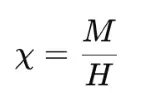Magnetism is a fundamental force of nature, and its study involves various physical quantities measured in distinct units. Understanding these units is crucial for grasping the principles of magnetic fields, magnetic forces, and their applications in technology and science. This article provides a detailed overview of the units used in magnetism and related concepts.
Magnetic Field (B-field)
The magnetic field, often referred to as the magnetic flux density or magnetic induction, is a vector field that describes the magnetic influence on moving electric charges, electric currents, and magnetic materials. The standard unit for measuring the magnetic field is the Tesla (T).

- Tesla (T): The SI unit of the magnetic field is named after the inventor Nikola Tesla. One Tesla is defined as one weber per square meter (1 T = 1 Wb/m²). It is a relatively large unit, so smaller magnetic fields are often measured in milliteslas (mT) or microteslas (µT).
Magnetic Flux
Magnetic flux quantifies the total magnetic field passing through a given area. The SI unit for magnetic flux is the Weber (Wb).
- Weber (Wb): One Weber is defined as the magnetic flux that, linking a circuit of one turn, produces an electromotive force of one volt as it is reduced to zero at a uniform rate in one second.
1 Wb = 1 V⋅s
- Maxwell (Mx): In the CGS system, magnetic flux is measured in Maxwells. One Weber is equivalent to 10^8 Maxwells.
1 Wb = 108 Mx
Magnetic Field Strength (H-field)
The magnetic field strength, or magnetizing force, is another important vector quantity that indicates the ability of an external magnetic field to induce a magnetic field in a material. The SI unit for magnetic field strength is the ampere per meter (A/m).
- Ampere per meter (A/m): This unit directly measures the magnetizing force in terms of the current (in amperes) producing a magnetic field in a certain length (in meters).
1 A/m
Magnetization
Magnetization represents the magnetic moment per unit volume of a material. It describes how much a material is magnetized when subjected to a magnetic field. The SI unit of magnetization is the ampere per meter (A/m).
Ampere per meter (A/m): This unit indicates the magnetic moment per unit volume.
1 A/m
Magnetic Dipole Moment
- The magnetic dipole moment is a measure of the strength and orientation of a magnetic source. It is a vector quantity that represents the magnetic strength of a magnet or current loop.
- Ampere square meter (A·m²): The SI unit for the magnetic dipole moment.
- Erg per gauss (erg/G): In the CGS system, the unit for magnetic dipole moment can be expressed as erg per gauss.
Permeability
Magnetic permeability is a measure of how easily a material can support the formation of a magnetic field within itself. It is denoted by the Greek letter µ.
Henry per meter (H/m): The SI unit of magnetic permeability is the henry per meter. The permeability of free space (vacuum) is a constant known as the magnetic constant (µ₀).
µ0 ≈ 4𝜋 × 10−7 H/m
Reluctance
Magnetic reluctance is the opposition offered by a material to the establishment of a magnetic field. It is analogous to electrical resistance in an electrical circuit.
Ampere-turn per weber (A·turn/Wb): The SI unit for magnetic reluctance.
Magnetic Susceptibility
Magnetic susceptibility indicates the degree to which a material can be magnetized in an external magnetic field. It is a dimensionless quantity.
Dimensionless: Magnetic susceptibility is often expressed as a pure number without units, denoting the ratio of magnetization to the applied magnetic field strength.

Summary of Units in Magnetism
Magnetic Field (B-field): Tesla (T), Gauss (G)
Magnetic Flux: Weber (Wb), Maxwell (Mx)
Magnetic Field Strength (H-field): Ampere per meter (A/m)
Magnetization: Ampere per meter (A/m)
Magnetic Dipole Moment: Ampere square meter (A·m²), Erg per gauss (erg/G)
Permeability: Henry per meter (H/m)
Reluctance: Ampere-turn per weber (A·turn/Wb)
Magnetic Susceptibility: Dimensionless
Conclusion
Understanding the various units used in magnetism and related concepts is essential for studying and applying magnetic phenomena in both theoretical and practical contexts. These units form the foundation for describing the behaviour of magnetic fields, the response of materials to magnetic forces, and the design of electromagnetic devices.




